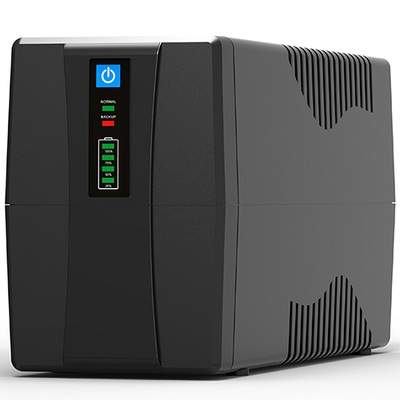If the mains is normal, the mains will convert the surge absorption filter circuit AC to DC circuit to DC to DC to convert the AC output of the AC circuit to supply the load and charge the battery. After the microprocessor control circuit detects the interruption of the commercial power, it immediately switches to the battery discharge DC conversion AC circuit and the AC output to supply the load. When the microprocessor control circuit detects the UPS failure, the UPS jumps to the bypass (BYPASS) through the relay (RELAY), is powered by the mains, and sends a buzzer to the user.

Advantages and Disadvantages of Online Interactive UPS
Online interactive UPS has the characteristics of simple circuit and low cost. High reliability. High efficiency, the efficiency is more than 95%. The overload capacity is strong, and the overload can be up to 200% under the mains power. Online interactive UPSs also have structural disadvantages. For example, in mains power, the output voltage improves amplitude, and input distortion, interference, etc. are passed to the output. The dynamic performance is not good. When the input voltage or load current changes sharply, the output voltage will undergo a huge sudden change, it will take a long time to restore the new stability, and the voltage adjustment accuracy will decrease. The scope of adaptation to the power grid is very narrow. In order to improve the accuracy and adaptability, the number of transformer taps must be increased. UPS has a transition time and is not suitable for generator power supply and unstable mains environment. The advantages of high frequency UPS:
(1) Small size and light weight, generally equivalent to 60% of the weight of a power frequency UPS of the same capacity. Since there is no output transformer, expansion and machine cycles are minimal.
(2) Boost switching rectifier has strong DC output voltage regulation capability, so it has strong adaptability to mains voltage fluctuations.
(3) The mains input power factor is above 0.99, the waveform content of the mains input current is less than 5%, and the pollution to the mains grid is small, which is the outstanding advantage of high-frequency UPS.
(4) Can eliminate audible noise (including electrical noise and mechanical noise).
Disadvantages of high frequency UPS:
(1) High frequency IGBT should be used, which can run under 20kHz UPS. The IGBT is expensive, with less supply, strict voltage and current working area, poor shock resistance, low reliability and high failure rate.
(2) The output DC voltage of the three-phase half-bridge Boost switching rectifier is high, generally 800 volts, and a charge-discharge management converter needs to be specially configured.
(3) Coupling high-frequency harmonics to the neutral line increases the 0-ground voltage of the output plane, which cannot meet the on-site requirements that the 0-ground voltage of server manufacturers such as IBM and HP is lower than 1V.
High frequency UPS has the following problems:
(1) The three-phase half-bridge SPWM inverter is a two-level inverter with poor harmonic elimination ability, large harmonic content and high size. When M<0.8, the harmonic amplitude is 1.36 times that of the fundamental wave, and the harmonic content will be larger when the dead zone is set, which is one of the main problems of high-frequency UPS.
(2) The high frequency increases the distribution parameters of the UPS circuit, which is easy to cause local vibration of the circuit, difficult to handle electromagnetic compatibility, high requirements on the production process, and increased difficulty in structural design.
(3) For high-frequency UPS, when the switching frequency is high to a certain value, skin effect and proximity effect will occur, which leads to the difficulties in materials and processes in the current high-power output isolation switch manufacturing. This is the fundamental reason why high-frequency UPS cannot use output isolators. However, the output isolation transformer is affected by many positive effects when working in UPS. For example, it can isolate zero voltage drop, short circuit impedance and high frequency attenuation isolation characteristics, improve the load impulse capability of UPS, the flow of zero sequence current and DC current. The capability of unbalanced loads with non-linear loads, etc. can be improved. Therefore, the inability to use an output isolation transformer is also one of the problems of high frequency UPS. The output isolating switch may not be used.
(4) It is not conducive to the realization of soft switching. The high frequency effect leads to qualitative changes in the performance of the inductance and capacitor, which affects the accurate resonance of the harmonic inductance of the soft switching circuit and the resonant capacitor, and cannot correctly implement ZVS or ACS lossless soft switching. Therefore, the high-frequency UPS does not use the soft switch at all, so the loss of the switch is inevitable. The higher the switching frequency, the greater the switching loss. Therefore, the high frequency of the UPS is at the expense of increasing the switching loss, only focusing on environmental protection, sacrificing energy saving, and not meeting the requirements of green UPS is another major problem of high frequency UPS. Therefore, in order to achieve energy saving standards, there are also online ups manufacturers who need to reduce frequency production, so some people say: medium frequency UPS.
 English
English
 Español
Español
 Português
Português
 русский
русский
 français
français
 日本語
日本語
 Deutsch
Deutsch
 Tiếng Việt
Tiếng Việt
 Italiano
Italiano
 Nederlands
Nederlands
 ไทย
ไทย
 Polski
Polski
 한국어
한국어
 Svenska
Svenska
 magyar
magyar
 Malay
Malay
 বাংলা
বাংলা
 Dansk
Dansk
 Suomi
Suomi
 हिन्दी
हिन्दी
 Pilipino
Pilipino
 Türk
Türk
 Gaeilge
Gaeilge
 عربى
عربى
 Indonesia
Indonesia
 norsk
norsk
 اردو
اردو
 čeština
čeština
 Ελληνικά
Ελληνικά
 Українська
Українська
 Javanese
Javanese
 فارسی
فارسی
 தமிழ்
தமிழ்
 తెలుగు
తెలుగు
 नेपाली
नेपाली
 Burmese
Burmese
 български
български
 ລາວ
ລາວ
 Latine
Latine
 Қазақ
Қазақ
 Euskal
Euskal
 Azərbaycan
Azərbaycan
 slovenský
slovenský
 Македонски
Македонски
 Lietuvos
Lietuvos
 Eesti Keel
Eesti Keel
 Română
Română
 Slovenski
Slovenski
 Српски
Српски
 Беларус
Беларус


